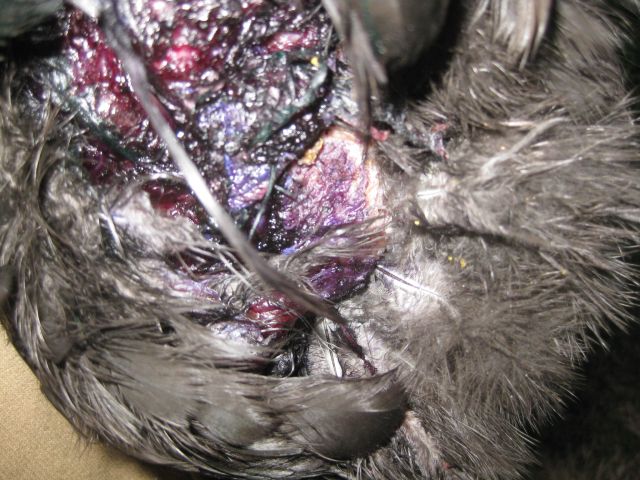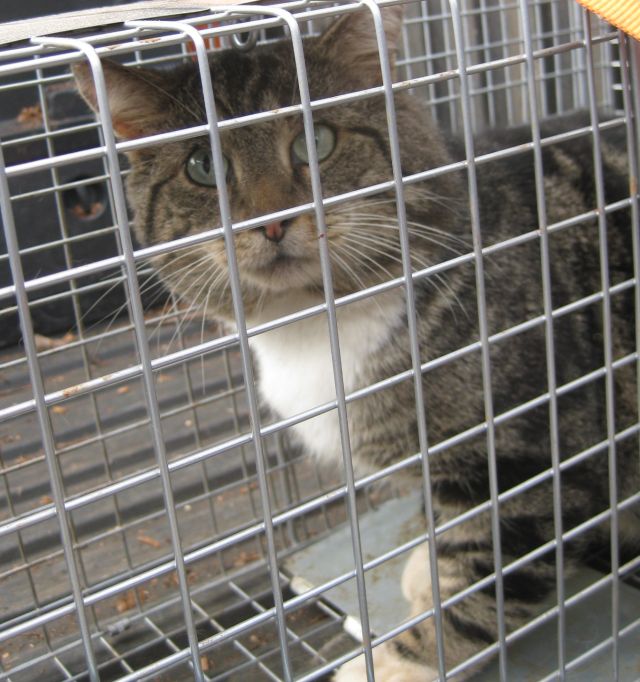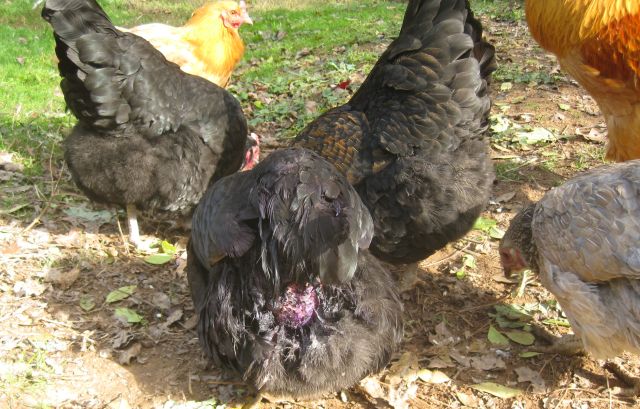I may not have mentioned that about 5 weeks ago a hen was taken by a predator, which reduced their number to 10 (1 rooster and 9 hens). Each morning a timer opens the coop door when the sun is well up and the chickens emerge to a 5ft high wire enclosed paddock. Except for 2 chickens – Randa and Wanda (from wanderer) who would fly over the fence to the greener grass the other side. Well 5 weeks ago Wanda was not to be seen except for a scattering of her feathers. The chickens at the time seemed agitated and I set the timer to open later each morning and for a while Randa stayed in the paddock with the others where they are well protected by the ever vigilant rooster, Buff of the 2″ spurs. Last Friday at lockup time I noticed that Randa and another hen, Bonnie (offspring of Buff and New Jersey Giant) were outside the paddock.
When we returned Saturday pm we immediately knew there was a problem. A pile of black feathers just outside the paddock area and 7 scared hens gathered in the furthest corner of the paddock where they rarely went. The rooster seemed fine but Randa and Bonnie were missing. The rest of the afternoon we searched for them. Unexpectedly Bonnie appeared with her tail feathers gone and, as the sun was sinking, we spotted Randa deep in the bush. So we had them back, now for a damage assessment.
And it wasn’t pretty – not only were Bonnie’s tail feathers missing but her hind quarters were badly mauled with blood, scabs of loose skin and globules of fatty flesh attached loosely to her rear. I was too concerned with treatment to take a picture at the time. So Sat night we swabbed down her rear end with a dilute mixture of H2O2 and then sprayed heavily with Blu-Kote, which is an antiseptic with a blue dye which colors the bloody areas thereby avoiding pecking attraction from the other chickens.

Sunday we visited the local Tractor Supply where I bought a live animal trap (32″x10″x12″ $40) and two 60 cent tins of cat food. M. had done research and was very interested in purchasing Vetericyn for $35 but I suggested ($35 seemed a lot to me) it was probably no more effective than Blu-Kote. I baited and set up the trap in the barn area and it was empty Monday morning. More research by M. convinced her we really needed Vetericyn and the winning argument which turned me, is that altho it is sprayed on it is a gel and so persists to keep the wound area protected from infection. Vetericyn was available at a closer, more expensive farm store for $40 (a $5 cost for arguing when I shouldn’t) and Mon evening we applied Vetericyn liberally.

Tuesday morning the trap, which had been relocated to the greenhouse was empty – a feral cat uses the greenhouse in cold weather but the weather has not been very cold. Tuesday night I located the trap in the carport where my security camera has shown a cat walking in the early morning hours. And when I arrived at 9am the cat was in the trap.

It may look cute in the cage but it is fearsome. Not once did it meeow but instead shook the cage back and forth as it tried to claw its way out. It is larger than it looks and is in good condition and strongly built. No wonder we have had no rodents or squirrels near the bird feeder this past year. I previously blogged that the disappearance of rodents in the chicken coop was due to two >5ft long snakes which cleared them out.
Now what to do with the cat. A store attendant said she shot cats with a .22 long gun (I call it a rifle) which was easier than trapping and taking them to a shelter where they would be euthanized. My neighbor this morning said he had relocated a stray dog more than 2 miles from his house and the next day it was back and he suggested I take the cat to the local shelter. The animal shelter receptionist said I could relocate the cat or give it to a chicken farm. I thought she was kidding – what will the chicken farm do with it? I asked and she said they keep cats to get rid of rodents. She also offered that I could bring it in and, for a cost of $25, they would neuter it and cut off the tip of one of its ears and give it to a chicken farm. The clipping of an ear signifies it has been neutered.

So off to the animal shelter where I paid $25 and was directed to a local vet where they said they would perform the procedure later in the day. They said I should call back for the cage – apparently they anesthetize the cat by injecting it while it is in the cage, which answered a riddle for me – how do you safely get a feral cat out of a cage?
And how is Bonnie doing? Despite pretty severe wounds she seems to be doing ok. Walking normally and eating as usual and no sign of a rampaging infection. We are hopeful.

postcript – I have been asked how do I know I caught the culprit since I never saw the predator which attacked the chickens. Several factors persuade me – there used to be several feral visitors, a large tawny cat and even a young cat which I once fed (big mistake). Past 6 weeks they have not been around. I think the cat in the trap moved into the area and cleared them out (or ate them). The only cat captured on my surveillance cameras the past week was the one in the trap. And finally, it was big enough and strong enough to catch and eat a chicken. Hopefully no more predations.
.

You cannot know that cat killed your chicken if you did not see it. And I’ve seen a few feral cats and that is someone’s house cat..not a feral cat.
Well, it did not have a collar and I live in a rural area where feral and stray cats of all sizes and colors abound.